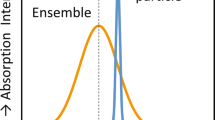Abstract
The defect-deformational (DD) theory of cooperative nucleation of ordered ensembles of nano-particles on the isotropic surface of solids with the participation of quasi-static Rayleigh waves (SRW) is developed. It is shown that the deposited atoms (surface defects) couple with the SRW to form quasi-static defect-deformation (DD) waves (gratings). Their wavenumbers form the fundamental DD wave excitation band. Nonlinear (three wave) interactions of the DD gratings within this band lead to the formation of the latent periodic DD structure which serves as a template for the subsequent growth of an ensemble of nanoparticles. Using a previously developed method, the size distribution function for this ensemble is calculated. The processes of degenerate parametric decay (DPD) and second harmonic generation (SHG) of DD waves are considered for the first time. The DPD of the spatial harmonics in the fundamental band is shown to lead to the formation of a bimodal nanoparticle size distribution function with maxima located at two values of nanoparticle size with ratio 1:2. Similarly, the SHG of DD waves from the fundamental band leads to the formation of bimodal nanoparticle size distribution. The obtained theoretical results are used for the interpretation of the experimental results on quasi-hexagonal bimodal nanoparticle ensembles formed under laser-assisted atoms deposition.
Similar content being viewed by others
References
K.F. MacDonald, V.A. Fedotov, S. Pochon, K.J. Ross, G.C. Stevens, N.I. Zheludev, W.S. Brocklesby, V.I. Emel’yanov, Appl. Phys. Lett. 80, 1643 (2002)
A.I. Denisyuk, K.F. MacDonald, F. Abajo, N.I. Zheludev, Jpn J. Appl. Phys. 48, 03A065 (2009)
H. Kissel, U. Müller, C. Walther, W.T. Masselink, Yu.I. Mazur, G.G. Tarasov, M.P. Lisitsa, Phys. Rev. B 62, 7213 (2000)
M.S. Hegazy, H.E. Elsayed-Ali, J. Appl. Phys. 104, 124302 (2008)
V.I. Emel’yanov, A.I. Mikaberidze, Phys. Rev. B 72, 235407 (2005)
V.I. Emel’yanov, in Progress in Nanothechnology, edited by Z. Bartul, J. Trenor (Nova Science Publ., 2012), Vol. 10, Chap. 1, pp. 1–59
V.I. Emel’yanov, Quantum Electron. 36, 489 (2006)
I.A. Kunin, Theory of Elastic Media with Microstructure(Springer, Berlin, Heidelberg, New York, 1982)
R.C. Picu, J. Mech. Phys. Solids 50, 1923 (2002)
L.D. Landau, E.M. Lifshitz, Theory of Elasticity (Pergamon, New York, 1986)
J. Miklowitz, The theory of elastic waves and waveguides (North-Holland, Amsterdam, New York, Oxford, 1978)
Y.R. Shen, Principles of Nonlinear Optics (John Wiley & Sons Inc., Hoboken, 2003)
Y. Kuramoto, Chemical Oscillations, Waves and Turbulence (Springer, Berlin, 1984)
G.I. Sivashinsky, Ann. Rev. Fluid Mech. 15, 179 (1983)
V.I. Emel’yanov, A.S. Kuratov (to be published)
V.I. Emel’yanov, K.I. Eremin, N.I. Zheludev, J. Exp. Theor. Phys. Lett. 76, 123 (2002)
M.J. Aziz, Defect and Diffusion Forum 153, 1 (1998)
H. Lee, R. Lowe-Webb, T.J. Johnson, W. Yang, P.C. Sercel, Appl. Phys. Lett. 73, 3556 (1998)
V.I. Emel’yanov, in Laser ablation in liquids, Principles and applications in the preparation of nanomaterials, edited by G. Yang (Pan Stanford Publ., Singapore, 2012), Chap. 1, pp. 1–109
Author information
Authors and Affiliations
Corresponding author
Rights and permissions
About this article
Cite this article
Emel’yanov, V., Kuratov, A. Degenerate parametric decay and second harmonic generation of quasistatic surface defect-deformational waves and bimodal nanoparticle size distributions. Eur. Phys. J. B 86, 270 (2013). https://doi.org/10.1140/epjb/e2013-40048-9
Received:
Revised:
Published:
DOI: https://doi.org/10.1140/epjb/e2013-40048-9




